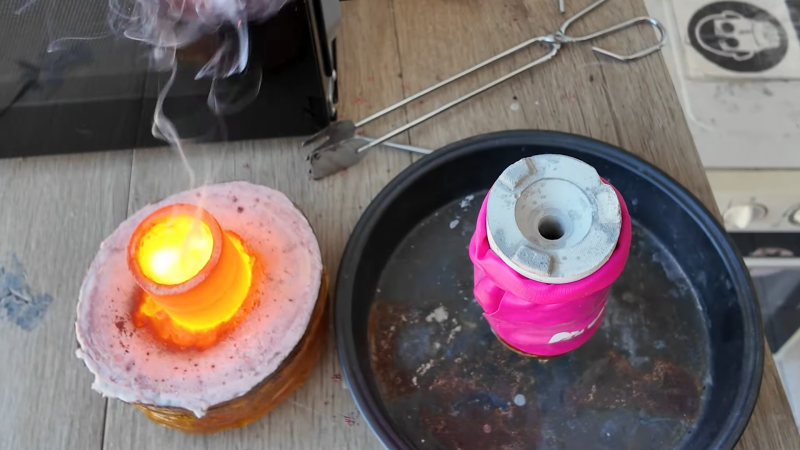If you think you can’t do investment casting because you don’t have a safe place to melt metal, think again. Metal casting in the kitchen is possible, as demonstrated by this over-the-top bathroom hook repair using a microwave forge.
Now, just because it’s possible doesn’t mean it’s advisable. There are a lot better ways to fix something as mundane as a broken bathroom hook, as [Denny] readily admits in the video below. But he’s been at the whole kitchen forging thing since building his microwave oven forge, which uses a special but easily constructed ceramic heat chamber to hold a silicon carbide crucible. So casting a replacement hook from brass seemed like a nice exercise.
The casting process starts with a 3D-printed model of the missing peg, which gets accessories such as a pouring sprue and a thread-forming screw attached to it with cheese wax. This goes into a 3D-printed mold which is filled with a refractory investment mix of plaster and sand. The green mold is put in an air fryer to dry, then wrapped in aluminum foil to protect it while the PLA is baked out in the microwave. Scrap brass gets its turn in the microwave before being poured into the mold, which is sitting in [Denny]’s vacuum casting rig.
The whole thing is over in seconds, and the results are pretty impressive. The vacuum rig ensures metal fills the mold evenly without voids or gaps. The brass even fills in around the screw, leaving a perfect internal thread. A little polishing and the peg is ready for bathroom duty. Overly complicated? Perhaps, but [Denny] clearly benefits from the practice jobs like this offer, and the look is pretty cool too. Still, we’d probably want to do this in the garage rather than the kitchen.















Going to have to try this one day soon (outside). Melting stuff in a microwave just says ‘Try me you know you want to’.
Stupid question, Is the use of the word “forge” for a melting furnace a British English thing? A forge is a (generally more open) furnace to heat metal to the point of welding or plasticity so you can beat it, roll it, or otherwise shape it. Foundry is melting and casting metal, usually done in a furnace for melting within a more confined space to raise it to higher melting temps more efficiently, Had a very simple carbon arc melting furnace in the basement as a kid, lots of juice and kind of slow, but awesome! Also why I will try the microwave thing outside – stuff happens….
As I read it here on Hackaday, the “forge” is the place/room where the action takes place. The thing (in the forge) that melts the metal is called the “hearth”.
Somewhere a blacksmith is giving us the stinkeye, I can feel it.
Speaking as a long-term resident of Sheffield, UK, definitely not. Forging is a completely different process to casting. You forge in a forge, you cast in a foundry. And you melt the metal in the furnace. (or melting furncae if you want to be more specific)
In the forge you heat the metal to be forged in the hearth.
They still forge and cast metal in Sheffield, look for Sheffield Forgemasters on that YouTube to see some immense equipment and lumps of hot metal the size of Japanese apartments.
“The furnace in the basement” means something different than metal-casting equipment, to Americans, I think.
Bad burritos…
Which is why I stated “carbon arc melting furnace” instead of furnace in the basement….
I discovered this dude a while ago, and am in awe with his process. He seems to have fine tuned many systems and processes through basic trial and error.
Hmm… that error part could be interesting with this topic…
‘Highball’ on youtube has done a lot of microwave sintering of 3D printed (metal filled filament) metal parts. He even got Aluminum to sinter pretty well